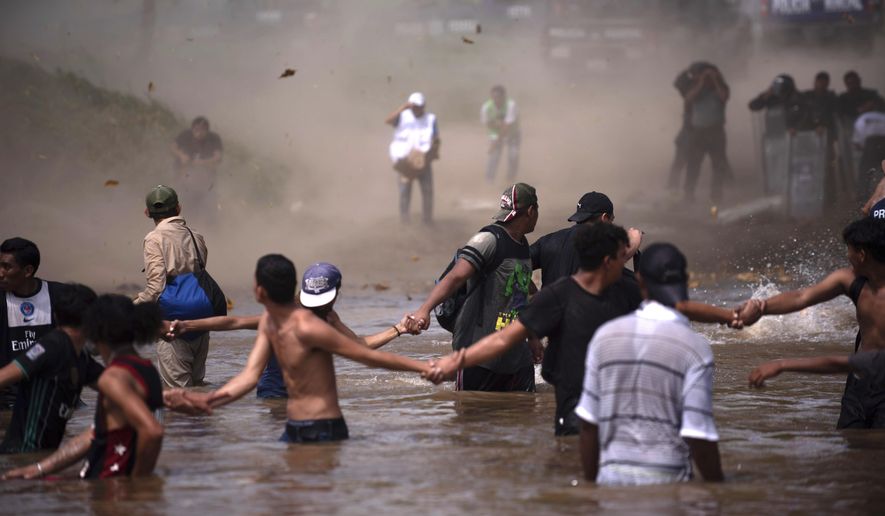TECUN UMAN, Guatemala — Several hundred migrants tried to cross the Suchiate River from Guatemala to Mexico en masse on Monday, but were met by ranks of Mexican federal police who blocked them from entering.
The standoff on the riverbank follow a more violent confrontation that occurred on the nearby bridge over the river the night before, when migrants tossed rocks and used sticks against Mexico police. One migrant was killed Sunday night by a head wound, but the cause was unclear.
While migrants on the bridge had appeared to be preparing for a second day of confrontations early Monday, instead they tried the route taken by the first caravan 10 days ago after it, too, was blocked: turn to the river below.
The first, larger caravan made it across the river by wading or on rafts, and now is advancing through southern Mexico.
But since that crossing, the Mexican Navy has begun patrolling the Suchiate River and Mexican police have taken up positions on the riverbank, insisting migrants register before entering and show travel documents that many do not have.
A Mexican helicopter hovered above a mass of several hundred migrants who had waded across the chest-high river Monday, apparently using the downdraft from its rotors to discourage them.
SEE ALSO: Second migrant caravan enters Mexico despite heavy police presence
Earlier Monday, about 600 migrants had gathered on the bridge, where Mexican federal police had blocked one end. The migrants had gasoline bombs made of soft-drink bottles, and improvised PVC tubes to launch fireworks or other projectiles.
On Sunday, the migrants broke through border barriers on the Guatemalan side of the bridge, only to confront Mexican police, who blocked them from entering Mexico.
Guatemala’s Interior Ministry said the second group had wounded Guatemalan police and used children as human shields, and Guatemalan firefighters confirmed that a 26-year-old Honduran had been killed from a blow to the head.
While migrants claimed he was hit by a rubber bullet, Mexican Interior Secretary Alfonso Navarrete Prida denied that his country’s forces had firearms or anything that could fire rubber bullets.
Navarrete Prida said Mexican federal police and immigration agents were attacked with rocks, glass bottles and fireworks when migrants broke through a gate on the Mexican side of the border, but were prevented from entering. Navarrete said some of the attackers carried guns and firebombs. There was no evidence that the first caravan had come with weapons.
“The Mexican government rejects the acts of violence on the border with Guatemala, and reiterates that the only way to enter Mexico is to obey immigration laws,” he said.
Meanwhile, some of the migrants in the initial caravan, now estimated at 4,000 people, began walking, and increasingly riding, from Tapanatepec, to Santiago Niltepec, 54 kilometers (33 miles) to the northwest.
While catching rides from passing trucks had been a largely impromptu habit in the first week of the caravan, it has now become more organized. On Monday, more than 100 migrants lined up at a gas station parking lot to wait for rides.
Mayor Ramiro Nolasco of the town of Zanatepec said local people had organized a bus and several trucks to carry migrants, mainly women and children. “We are helping our brothers from other countries with food, water, and transportation,” Nolasco said. “It is going to be very little, compared to what they need.”
The caravan still must travel roughly 1,000 miles (1,600 kilometers) to reach the nearest U.S. border crossing at McAllen, Texas. The trip could be twice as long if the migrants head for the Tijuana-San Diego frontier, as another caravan did earlier this year. Only about 200 in that smaller group made it to the border.
Most of the migrants in the caravan appeared determined to reach the U.S., despite an offer of refuge in Mexico.
Mexican President Enrique Pena Nieto launched a program Friday dubbed “You are home,” which promises shelter, medical attention, schooling and jobs to Central Americans who agree to stay in the southern Mexico states of Chiapas or Oaxaca, far from the U.S. border.
Mexico’s interior minister said Sunday that temporary identity numbers had been issued to more than 300 migrants, which would allow them to stay and work in Mexico. The ministry said pregnant women, children and the elderly were among those who had joined the program and were now being attended at shelters.
He said 1,895 had applied for refugee status in Mexico.
• Associated Press writers Christopher Sherman in Tapanatepec and Sonia Perez D. in Guatemala City contributed to this report.




Please read our comment policy before commenting.